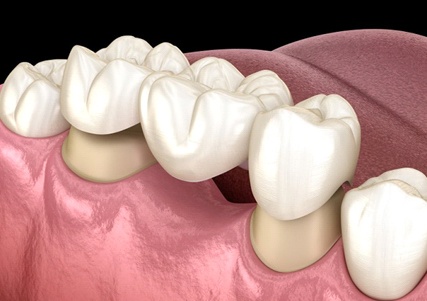
Dental Bridges – Saginaw, TX
Bridge the Gap in Your Smile
Are your missing teeth making it hard to enjoy life? Is speaking, eating, and confidently smiling hard for you due to the gaps in your grin? Sounds like you could benefit from getting a dental bridge in Saginaw. This string of artificial teeth is designed to literally bridge the gap in your smile, hence the name. If you’re missing one or more consecutive teeth in the Saginaw, TX area, contact us today to learn whether bridges are the right solution for you.

Why Choose Saginaw Dental for Dental Bridges?
- Lifelike Restorations Used to Replace Missing Teeth
- Convenient Hours in a Modern Dental Office
- Implant-Retained Bridges Available
What Are Dental Bridges?

A dental bridge is a series of crowns strung together to replace one or more missing teeth. The crowns on either end of the bridge are anchored onto your remaining natural teeth. In traditional bridges, the crowns in the center of the bridge are known as pontics, and are designed to fill the space and prevent your existing teeth from drifting and trying to fill in the gap themselves.
The other form of bridges is held in place with dental implants. With this method, crowns don’t have to be placed over any of your existing teeth. Instead, an implant is placed on either side of the gap in your grin. Then, crowns are fitted over the implants, with the pontics in between them. Implant-retained bridges offer more benefits than traditional bridges, such as preventing jawbone loss and not requiring any existing tooth enamel to be removed to make room for a crown.
The Bridge Process

The process for getting a dental bridge may take up to several appointments with your dentist in Saginaw, Dr. Renkuntla. During the first visit, he might need to file down the teeth at either end of the gap, known as the abutment teeth, so that the crowns can more easily slip over them. Next, he will take impressions to give the dental lab an exact mold to use when crafting your bridge. While this permanent bridge is being created, we can fix you with a temporary bridge to protect your exposed teeth and gums.
When you return for your second appointment, we’ll remove your temporary and place your permanent bridge. We’ll make adjustment as needed until your bridge fits just right and perfectly fills the gap in your smile.
Benefits of Bridges

Dental bridges come with a whole host of benefits, including:
- Restoring your ability to smile with confidence
- Restoring your ability to easily talk and chew
- Maintaining the shape of your face
- Properly distributing the forces in your bite
- Preventing remaining teeth from drifting to fill in the gap
Dental Bridge FAQs

Losing one or more teeth along the upper or lower arch might leave you feeling a bit self-conscious and fearful of how you will eat and speak. Over time, these teeth may have suffered damage or severe decay, and now that they are no longer in place, it’s becoming more difficult to practice normal daily tasks. But with a dental bridge in Saginaw, we know you can find hope in a full, complete smile once again. But as it is with most dental treatments, you likely have many questions. To help answer some, we’ve compiled the following information for you to review.
How long should a dental bridge last?
On average, a dental bridge can last anywhere from 5-15 years. The timeframe ultimately depends on how well you take care of your new teeth once they are in place. But it’s also important to factor in the type of material that is used to create your bridge as well as where it will sit inside the mouth. The reason the location is so important is that when placed toward the back, chewing motions are more likely to cause it to wear down quicker. If placed toward the front of your mouth, it’s likely to last much longer.
Does getting a bridge hurt?
No, you should not expect to be in any pain while receiving a dental bridge. Before it is put into place, we will make sure to administer a numbing agent so that you feel no discomfort. This local anesthetic will help to keep you calm and pain-free throughout your visit. While it is necessary to remove small portions of your abutment teeth to ensure proper placement, you will not feel any of it but instead, enjoy sturdy anchors that will help to hold your dental bridge in place.
Once your new teeth are properly situated, you can expect to feel some soreness after your appointment that may last for a few days. Fortunately, you can take an over-the-counter pain reliever to minimize discomfort and sensitivity.
Do dental bridges look natural?
When crafted from natural-looking materials like porcelain or ceramic, you can expect your dental bridge to blend with the rest of your smile. Your dentist will shade your new teeth to match your existing ones so that no one will be able to tell the difference. The specifications provided to lab technicians will allow them to fabricate a prosthesis that will not only offer optimal oral health but beautiful aesthetics as well.
How do I clean under my bridge?
To make sure that you do not develop cavities or gum disease while wearing your dental bridge, you’ll need to make sure that you take proper care of your mouth. This includes keeping the underside of your dental bridge clean. This may seem like an impossible feat, but it can easily be done by using dental floss to help remove bacteria. You can also opt for an interdental brush to reach difficult areas and remove any trapped food that is underneath your bridge. Finally, you’ll want to invest in a Waterpik or similar type of water irrigator, as this help to flush out any additional bacteria that can cause gum disease.